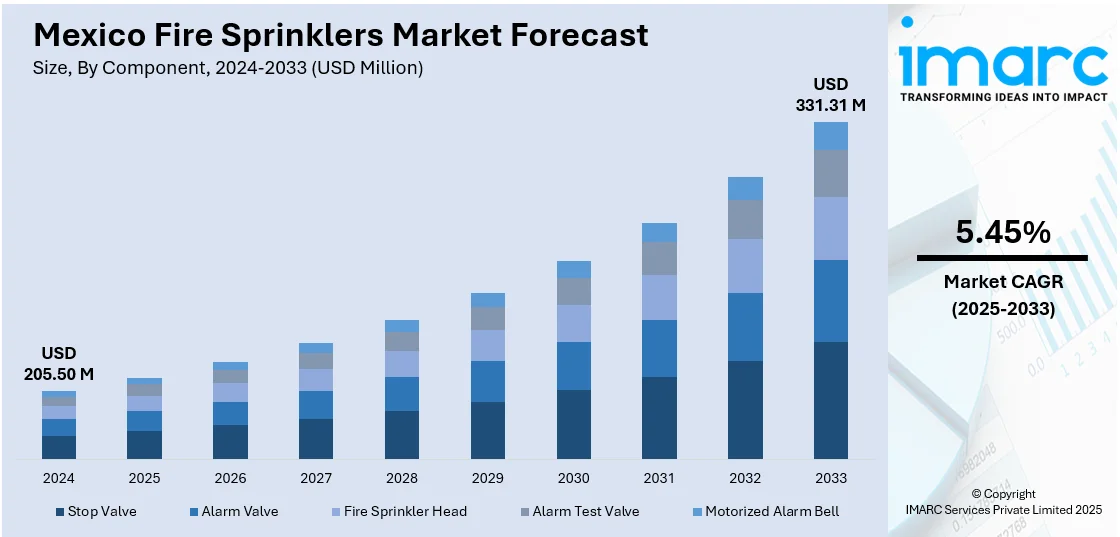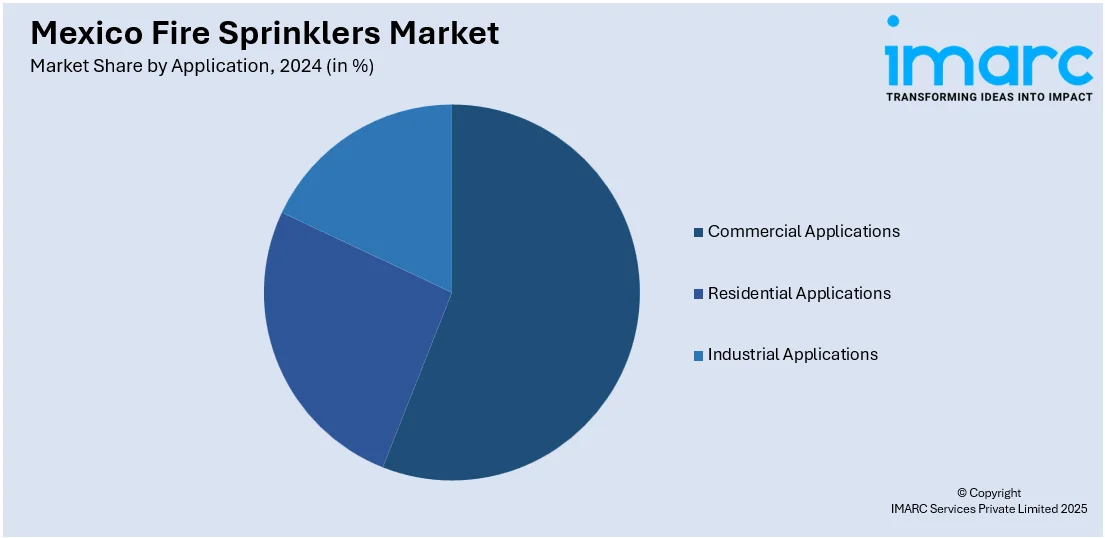
Mexico Fire Sprinklers Market Size, Share, Trends and Forecast by Component, Product Type, Service, Technology, Application, and Region, 2025-2033
Mexico Fire Sprinklers Market Overview:
The Mexico fire sprinklers market size reached USD 205.50 Million in 2024. Looking forward, IMARC Group expects the market to reach USD 331.31 Million by 2033, exhibiting a growth rate (CAGR) of 5.45% during 2025-2033. The market is experiencing steady growth due to robust fire safety regulations, increasing construction activities, and greater awareness about fire threats. Stringent building codes enforced by the government requiring fire suppression systems and rapid urbanization have contributed to the rising demand for effective fire protection systems.
|
Report Attribute
|
Key Statistics
|
|---|---|
|
Base Year
|
2024
|
|
Forecast Years
|
2025-2033
|
|
Historical Years
|
2019-2024
|
| Market Size in 2024 | USD 205.50 Million |
| Market Forecast in 2033 | USD 331.31 Million |
| Market Growth Rate 2025-2033 | 5.45% |
Mexico Fire Sprinklers Market Trends:
Strict Fire Safety Regulations
The Mexico fire sprinklers market growth is greatly fueled by strict fire safety regulations in the country. The government has enacted comprehensive building codes requiring the installation of fire suppression systems, which include sprinklers, in different types of buildings. The efforts are made to increase public safety and reduce the risk of fire outbreaks. In line with this, property developers, building owners, and facility managers are increasingly taking up fire sprinkler systems in order to adhere to regulations as well as save occupants. Imposition of regulations has created steady demand for installations of fire sprinklers in the residential, commercial, and industrial markets. Besides, regular improvements in fire safety codes further drive the use of sophisticated fire protection technologies, as these systems maintain effectiveness in stopping fire risks. This regulatory environment is instrumental in determining the growth trajectory of Mexico's fire sprinkler market. Recently, the Latin American Fire Protection Network (Latam PCI), the Mexican Association of Automatic Fire Sprinklers (AMRACI), along with the National Fire Protection Council (CONAPCI) urged Mexican authorities, such as the Congress of the Union and pertinent ministries, to work together on creating new legislation. They suggest establishing a comprehensive legal structure centered on “Human Security and Fire Protection,” which would be straightforward, contemporary, and routinely assessed. They suggest initiating extensive public education initiatives to enhance awareness of fire prevention and promote a culture of safety. AMRACI and CONAPCI expressed their willingness to assist institutions and the government in this endeavor.

Technological Developments in Fire Sprinkler Systems
The use of advanced technologies is one of the primary factors influencing the Mexico fire sprinklers market outlook. Currently, there is a focus on designing intelligent sprinkler systems with smart sensors, IoT connectivity, and automatic controls. These technologies provide real-time surveillance, timely detection of fire risks, and immediate sprinkler activation, thus improving the efficiency and effectiveness of fire suppression operations. Moreover, the use of corrosion-resistant materials and energy-saving components adds to the durability and sustainability of fire sprinkler systems. The. adoption of these advanced systems is mostly common in areas like that of data centers, hospitals, and manufacturing plants, where there is need for an instant response to fire outbreaks. With emerging technologies, demand for complex fire sprinkler systems is expected to increase, thus, accelerating market growth in Mexico.
Expansion across Various Sectors
The Mexico fire sprinklers market share is increasing due to rising awareness about fire safety and the need for building code compliance. Commercial and industrial sectors have long been the major implementers of fire sprinkler systems, but the trend is now shifting toward installation of these systems in residential structures, schools, and hospitals. This expanding use is influenced by the identification of fire hazards in different environments and the need to protect lives and property. Furthermore, the increased activity levels in construction and urban development projects have also increased the demand for fire sprinkler installations. Government incentives and funding for fire safety measures also account for the spread of sprinkler systems in different industries. As the market becomes diversified, producers are modifying their products to fit the specific needs and standards of each industry to provide solutions for fire protection.
Mexico Fire Sprinklers Market Segmentation:
IMARC Group provides an analysis of the key trends in each segment of the market, along with forecasts at the country and regional levels for 2025-2033. Our report has categorized the market based on component, product type, service, technology, and application.
Component Insights:
- Stop Valve
- Alarm Valve
- Fire Sprinkler Head
- Alarm Test Valve
- Motorized Alarm Bell
The report has provided a detailed breakup and analysis of the market based on the component. This includes stop valve, alarm valve, fire sprinkler head, alarm test valve, and motorized alarm bell.
Product Type Insights:
- Wet Pipe Fire Sprinklers
- Dry Pipe Fire Sprinklers
- Deluge Systems
- Pre-Action Systems
- Others
The report has provided a detailed breakup and analysis of the market based on the product type. This includes wet pipe fire sprinklers, dry pipe fire sprinklers, deluge systems, pre-action systems, and others.
Service Insights:
- Engineering Services
- Installation
- Design Maintenance
- Inspection
- Managed Services
- Others
A detailed breakup and analysis of the market based on the service has also been provided in the report. This includes engineering services, installation, design maintenance, inspection, managed services, and others.
Technology Insights:
- Active Fire Protection
- Passive Fire Protection
The report has provided a detailed breakup and analysis of the market based on the technology. This includes active fire protection and passive fire protection.
Application Insights:

- Commercial Applications
- Residential Applications
- Industrial Applications
A detailed breakup and analysis of the market based on the application has also been provided in the report. This includes commercial applications, residential applications, and industrial applications.
Regional Insights:
- Northern Mexico
- Central Mexico
- Southern Mexico
- Others
The report has also provided a comprehensive analysis of all the major regional markets, which include Northern Mexico, Central Mexico, Southern Mexico and others.
Competitive Landscape:
The market research report has also provided a comprehensive analysis of the competitive landscape. Competitive analysis such as market structure, key player positioning, top winning strategies, competitive dashboard, and company evaluation quadrant has been covered in the report. Also, detailed profiles of all major companies have been provided.
Mexico Fire Sprinklers Market Report Coverage:
| Report Features | Details |
|---|---|
| Base Year of the Analysis | 2024 |
| Historical Period | 2019-2024 |
| Forecast Period | 2025-2033 |
| Units | Million USD |
| Scope of the Report |
Exploration of Historical Trends and Market Outlook, Industry Catalysts and Challenges, Segment-Wise Historical and Future Market Assessment:
|
| Components Covered | Stop Valve, Alarm Valve, Fire Sprinkler Head, Alarm Test Valve, Motorized Alarm Bell |
| Product Types Covered | Wet Pipe Fire Sprinklers, Dry Pipe Fire Sprinklers, Deluge Systems, Pre-Action Systems, Others |
| Services Covered | Engineering Services, Installation, Design Maintenance, Inspection, Managed Services, Others |
| Technologies Covered | Active Fire Protection, Passive Fire Protection |
| Applications Covered | Commercial Applications, Residential Applications, Industrial Applications |
| Regions Covered | Northern Mexico, Central Mexico, Southern Mexico, Others |
| Customization Scope | 10% Free Customization |
| Post-Sale Analyst Support | 10-12 Weeks |
| Delivery Format | PDF and Excel through Email (We can also provide the editable version of the report in PPT/Word format on special request) |
Key Questions Answered in This Report:
- How has the Mexico fire sprinklers market performed so far and how will it perform in the coming years?
- What is the breakup of the Mexico fire sprinklers market on the basis of component?
- What is the breakup of the Mexico fire sprinklers market on the basis of product type?
- What is the breakup of the Mexico fire sprinklers market on the basis of service?
- What is the breakup of the Mexico fire sprinklers market on the basis of technology?
- What is the breakup of the Mexico fire sprinklers market on the basis of application?
- What is the breakup of the Mexico fire sprinklers market on the basis of region?
- What are the various stages in the value chain of the Mexico fire sprinklers market?
- What are the key driving factors and challenges in the Mexico fire sprinklers?
- What is the structure of the Mexico fire sprinklers market and who are the key players?
- What is the degree of competition in the Mexico fire sprinklers market?
Key Benefits for Stakeholders:
- IMARC’s industry report offers a comprehensive quantitative analysis of various market segments, historical and current market trends, market forecasts, and dynamics of the Mexico fire sprinklers market from 2019-2033.
- The research report provides the latest information on the market drivers, challenges, and opportunities in the Mexico fire sprinklers market.
- Porter's five forces analysis assist stakeholders in assessing the impact of new entrants, competitive rivalry, supplier power, buyer power, and the threat of substitution. It helps stakeholders to analyze the level of competition within the Mexico fire sprinklers industry and its attractiveness.
- Competitive landscape allows stakeholders to understand their competitive environment and provides an insight into the current positions of key players in the market.
Need more help?
- Speak to our experienced analysts for insights on the current market scenarios.
- Include additional segments and countries to customize the report as per your requirement.
- Gain an unparalleled competitive advantage in your domain by understanding how to utilize the report and positively impacting your operations and revenue.
- For further assistance, please connect with our analysts.
 Request Customization
Request Customization
 Speak to an Analyst
Speak to an Analyst
 Request Brochure
Request Brochure
 Inquire Before Buying
Inquire Before Buying




.webp)




.webp)












